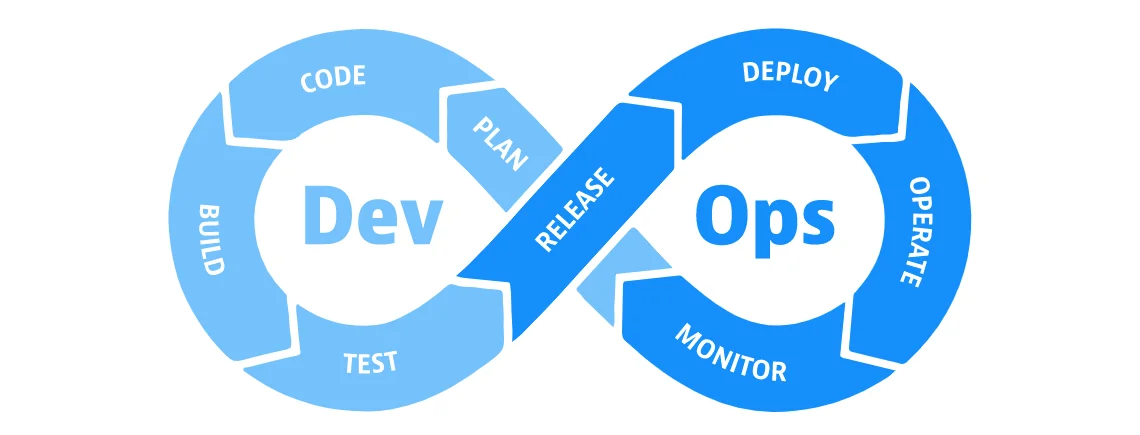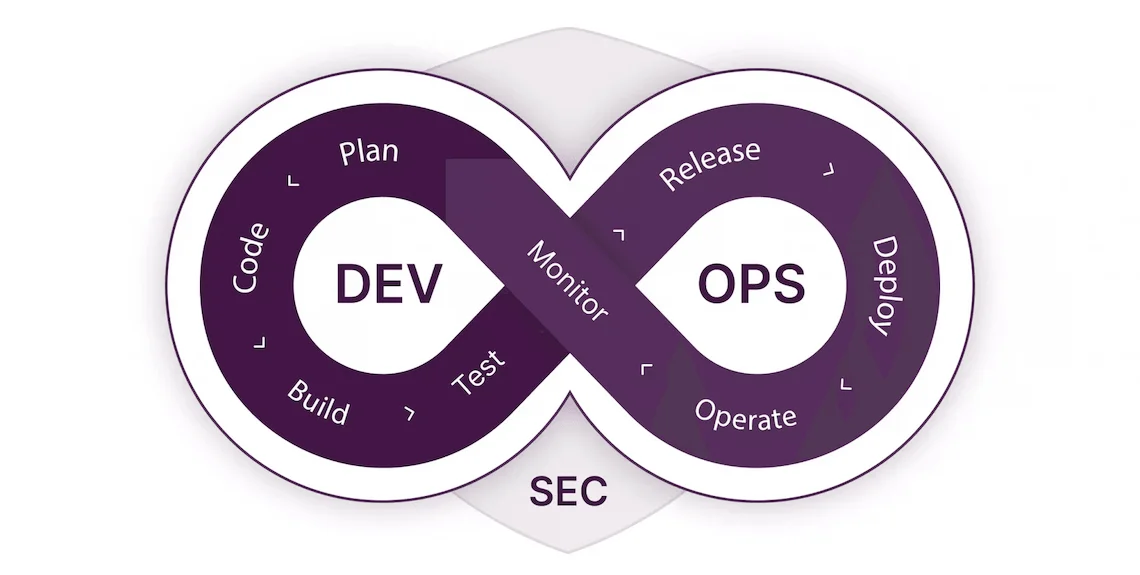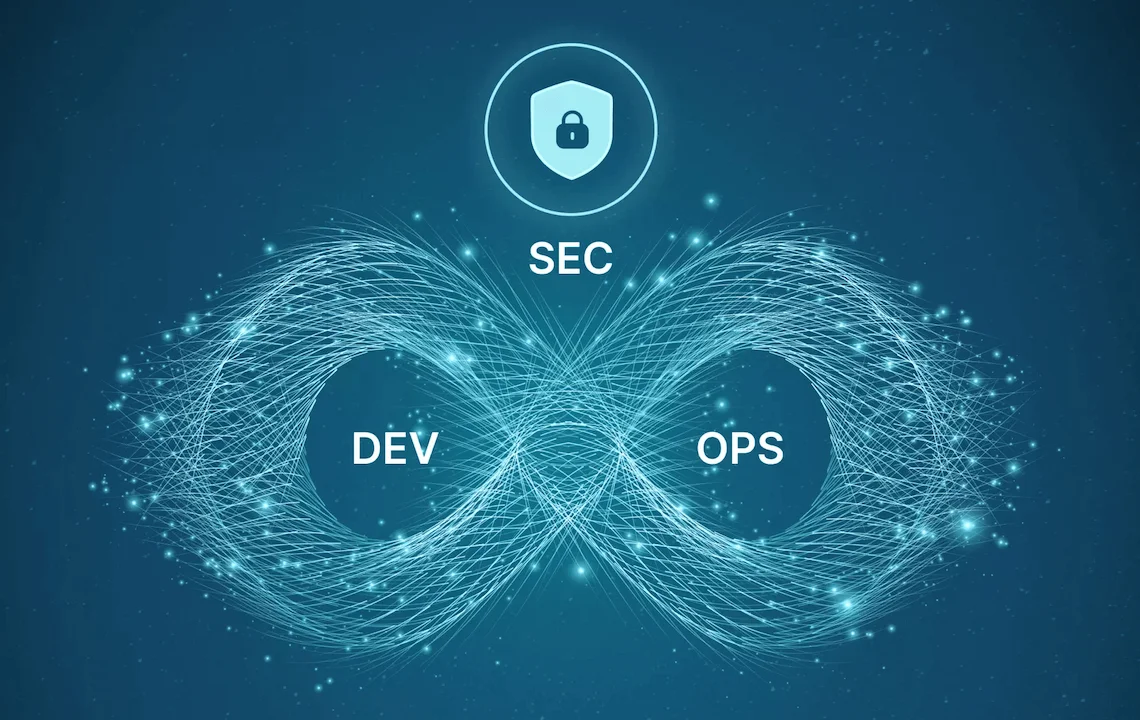DevOps & DevSecOps: What Are the Key Differences Between the Two?
- DevOps
- November 4, 2022
The terms DevOps and DevSecOps have been in the air of technology for a long time. But, still, the concepts of these two terms have been misunderstood by many; many are not even aware of the differences these terms have.
Here we are not just going to dive into the concept of DevOps and DevSecOps but we are going to swim around through them.
By the end of this article, for those of us who are muddled up with the concept of DevOps, DevSecOps, SecOps, SecDevOps, and a lot more, it will be clear to you all thoroughly. Let’s kickstart with the basics.
What is DevOps?
DevOps is the very first methodology that’s made with the synergy of two core focuses of computer science. Well, the name DevOps might have given you the hint about what are these very two focuses we are talking about, it’s software development and operations.

The market ratio of the global DevOps market was USD 4,311.95 million in 2020. It is expected to grow at a compound annual growth rate of 18.95%. The projected market value of DevOps by 2026 will be USD 12,215.54 million.
By observing DevOps practices throughout a development cycle, developers are enabled to have tremendous control over product infrastructure and they are able to prioritize software performance over other purposes.
DevOps’s key objective is to smoothen up the flow of work with coding, testing, and deploying code on production servers by reducing the risk factors at each and every step.
What are the key advantages of DevOps?
Here you will get to know about the points that make DevOps look better and apart from the other mainstream technologies, take a look below:
1. Stabilize the work environment
The process of debugging, adding new features, or fixing up the current code sometimes distresses the developers out there which affects productivity in work pretty adversely. Following the DevOps practices streamlines the whole process and alleviates your tasks relatively.
2. DevOps allows you to bring innovation to your ideas
DevOps methodology promotes automation, naturally, it offers you methodologies that take care of repetitive tasks with automation. Unlike conventional methods, DevOps allows you to focus on tasks that are prior and require mental effort. 70% of DevOps teams release code continuously, once a day, or every few days, up 11% from 2021.
3. DevOps encourages agility in businesses
There is no doubt that agility in your business can help you stay on top. All credit goes to DevOps, with DevOps solutions you can obtain the scalability that is needed to transform the business.
4. Minimal cost of production
As DevOps helps you do a proper collaboration, it inadvertently helps you save a lot of money that was spent unnecessarily earlier. You will see a relative difference in the money you spent on the production costs of your departments, as both maintenance and new updates are carried under a broader single umbrella.
5. Continuous delivery of software
When it comes to DevOps methodology, the core purpose of the same is that all the departments are equally liable for maintaining stability and offering upgraded features. This is the reason why the delivery of software is pretty smooth and rapid, unlike conventional methods.
6. The results are nothing but high-quality products
The healthy coordination and collaboration between development teams and operations teams lead to better results and high-quality products. Considering users’ feedback on a frequent basis adds more value to the business.
These are the top six benefits of DevOps that make it superior to traditional methodologies.
What is DevSecOps?
DevSecOps, as the name suggests, is the integration of Development, Security, and Operations. This development practice integrates security at every level of the software development cycle for the sake of delivering security-oriented and robust applications.

DevSecOps infuses the additional layer of security into CI/CD pipeline continuous integration and continuous delivery by authorizing the development team to consider every important challenge which is in contact with security with DevOps speed.
If talking about the traditional practices, the factors of security considerations and the practices related to the same were kept on a prior note and were introduced at the end stage of the development cycle.
But as time passed by, the cybersecurity attackers came up with advanced strategies which enabled the development teams to come up with advanced practices and this is how DevSecOps became a go-to solution for guaranteeing applications are protected in this modern development ecosystem.
What are the Benefits of DevSecOps?
Let’s refer to the top benefits of DevSecOps to learn more about this concept:
1. Robust application security
DevSecOps embeds a robust approach to lessen down the cybersecurity threats and risks at the very beginning of the development cycle. This means that the development teams will be dependent on automated security tools when it comes to testing the code on the fly, right after conducting security audits without slowing the development process.
Subsequently, the DevOps team will be responsible for reviewing, auditing, scanning, testing, and debugging the code at the multiple stages of the development cycle in order to make sure that the application is considering all the critical security checkpoints.
If any security vulnerabilities are being captured then the security team and development team will work together to address the issue and come up with a solution.
2. Streamline model delivery
The emergence of DevSecOps is done with the target of embedding security at the very beginning of the development cycle by automating the process and enabling compliance teams to ensure that the security practices encourage rapid development cycles.
When it comes to traditional development methods, the development cycle of an application is carried out till the end without keeping a check on security factors. When any security-related vulnerabilities are captured then the solution is brought which causes many delays in bringing the application to production.
3. Cross-team ownership and coordination
The core purpose of DevSecOps is to bring and make both the application team and security team collaborate together from the very beginning.
The principles of DevOps and DevSecOps are absolutely against disparate operations, they follow the approach of collaborative teamwork which ensures better and streamlined results along with a speedy process.
4. Security vulnerabilities
The biggest advantage that DevSecOps offers is automation, you can leverage automation right from capturing to getting the solutions for your security vulnerabilities.
You can use pre-built scanning solutions to monitor any prebuilt container images in the build pipeline for CVEs. DevSecOps also helps you monitor security measures that not only alleviate security risks but also help with insights to teams so that teams can work on the same fast when vulnerabilities are captured.
Yet another benefit that DevSecOps offers is the streamlined agile development process, if it’s performed properly then it can help the development team with robust security and quite fewer safety vulnerabilities.
What are the Similarities Between DevOps and DevSecOps?
For the sake of the common differences between DevOps and DevSecOps, we cannot ignore what similarities they share. Let’s take a look at the common points between DevOps and DevSecOps:
1. Collaborative culture
The collaborative culture is the biggest characteristic that sets DevSecOps and DevOps apart from traditional methodologies. The key purpose of these two concepts is to streamline the development process along with saving a whole lot of time and money. DevSecOps and DevOps are absolutely against discrete work culture.
Apart from this, DevOps and DevSecOps help the teams accomplish development objectives like quicker iteration and deployment that do not cause any risk and do not let the security of the app have interfered.
Both DevSecOps and DevOps do comprise the collaboration of multiple teams that were earlier siloed (development and IT operations or development, IT operations, and security) for the sake of increasing visibility across the application’s lifecycle right from planning to application performance regularizing.
2. Infrastructure as Code (IAC)
Infrastructure as Code is the feature that enables you to design and implement the infrastructure you look for through code.
This process does not call for an IT professional to perform manual tasks like configuring servers, managing operating systems, installing software packages, and other things that require a lot of human mental labor.
3. Active monitoring
The concept of both DevOps and DevSecOps do promote active monitoring of data to stimulate learning and easy adaptation. Consistent monitoring and analysis of the app’s data is a pretty good practice in order to create better and data-driven software in the future.
Moreover, real-time monitoring and analysis of data allow the team to fix the vulnerabilities of the application faster along with improvising the current security practices; leveling them toward betterment all for the sake of optimizing application performance.
4. Automation
The term automation is something that defines the concept of DevOps and DevSecOps apart from collaborative teamwork. Automation is pretty necessary when it comes to DevOps and DevSecOps as it takes care of eliminating and managing regular repetitive tasks without any involvement of an IT professional.
Also, DevSecOps do use automation for running and checking constant real-time data for security purposes and avoid security-related vulnerabilities.
5. Microservices
If we explain things to you about microservices simply, microservices are the small aspects of the application that are assembled to create an entire system.
With the implementation of microservice architecture, developers can alleviate their jobs by breaking down complex code into small pieces for easier and simpler management.
6. Faster iteration and quicker release
We already have discussed multiple times that DevOps and DevSecOps do encourage the concept of shared responsibility. As the teams are working together and are liable for bringing out the best results in every specific aspect which will also cut the time short relatively.
As the teams are able to save a whole lot of time, productivity is achieved, and the teams are able to get more tasks done in a shorter period of time. With this process, the organizations are now able to run more iterations along with the improved quality of applications and more product releases.
So, these are the 6 major similarities DevOps and DevSecOps do share.
What is SecOps?
Here we are introducing yet another member of the family: SecOps. SecOps as its name suggests is the merger of two different concepts; Sec represents cybersecurity, as you would have assumed already, and Ops is nothing but operations.
Key Goals of SecOps:
- To keep the cybersecurity concerns on a prior note at every stage of the development process
- Considering the concept of security dynamic so that it could be improved and adaptive
- To allocate the responsibility related to security to all the involved teams.
3 Key Responsibilities of SecOps
Here are the 3 key responsibilities of SecOps that make the organization opt for the same:
1. Incident response
SecOps teams are mainly accountable for managing and implementing the incident response plan whenever there is an arrival of any unauthorized and unexpected event.
Incident response is the best friend of the development team if there is any unexpected vulnerability about security or any other risk factor as it arrests it before any end-user comes across the same.
When any unauthorized access is being identified or somebody is trying to breach the code then incident response alerts the team immediately in order to prevent the attacker from obtaining furthermore access to the network.
2. Root cause analysis
The analysis that SecOps team carries out is something that depth is deeper than the word depth. Not only does the team catches the unauthorized issue or a sudden risk factor that harms the security of the app, but it also intimates the team and alerts it to take the required step. Just to prevent it with the usage of special software.
3. Threat intelligence
Threat intelligence is the two-step security procedure that comprises obtaining knowledge and learning about the potential security risks which can be caused to the company. Also, it does develop strategies to recognize security threats and respond accordingly.
How to Convert from DevOps to DevSecOps?
Now that we are much influenced by the concept of SecOps and DevSecOps, let’s learn how can you convert DevOps into DevSecOps:
1. Start preparing a team for it
Before you actually dig into the process of converting DevOps into DevSecOps, you are supposed to create a specific team for DevSecOps so that you do not face any hurdles in the future.
You are supposed to raise awareness among your team members regarding considering the issue of security prior to others and implementing the same at the very beginning of your development process.
2. Shift security left
The security protocols will be embedded before the application is about to launch or it’s going to take a little longer to be developed. All that DevSecOps considers is to keep security on a prior note so that it can be addressed instantly and the required steps are being followed if there’s any occurrence of any unauthorized access.
3. Choose the apt combination of security testing methods
You will get your hands on a lot of viable testing tools out there that will ultimately make your choice harder when it comes to choosing the best of all. Here we are helping you select any of the top 4 testing methods:
SAST: Static application security testing that allows you to recognize shortcomings by analyzing your code.
DAST: Dynamic application security testing that puts administrators in the shoes of an attacker to enable you to capture gaps and vulnerabilities.
IAST: Interactive application security testing is the combination of both SAST and DAST to use software instrumentation (active or passive) to keep a check on application performance.
RASP: Runtime application self-protection uses real-time application data to identify and attacks that take place, independently of an administrator.
4. Setting coding standards for your DevSecOps team
As the main standard of the DevSecOps team is to consider security on top, the coding standards have to be competent enough. What you can do is ensure that your code is robust and standardized, and your team will have ample time to secure it in the future.
Moreover, if you do not have it, you can easily establish a system of instructing developers on coding best practices and make sure that code changes can be implemented smoothly.
So, these are the 4 key practices that will help you convert your DevOps into DevSecOps.
Difference Between DevOps and DevSecOps – The Discussion
Finally, we are here to discuss the most awaited segment of this topic, the key differences between the concept of DevOps and DevSecOps:
DevOps
DevOps’s prime focus is on collaboration between application teams from the beginning of the app development to the deployment process. Development and operations teams work hand-in-hand to integrate shared KPIs and tools.
The key objective of the concept of DevOps is to elevate the frequency of deployments along with focusing equally on the predictability and efficiency of the application.
If we are talking about team DevOps then the DevOps engineers do think about things like how they can deploy updates to an app as seamlessly and brilliantly as possible with no adverse impact on the user experience.
As the team DevOps keeps focusing majorly on optimizing the speed of delivery, the team doesn’t always consider the issue of security and threats on a prior note that later create trouble in the app development by encouraging security-related vulnerabilities that can destroy the application, end-user data, and proprietary company assets.
DevSecOps
DevSecOps is more like an evolved form of DevOps as development teams started to realize that the DevOps model was not addressing security concerns to the fullest. Instead of retrofitting security into the build, DevSecOps emerged as a way to integrate the management of security from the very beginning throughout the development procedure.
With this method, application security starts at the outset of the build process, instead of at the end of the development pipeline. With this upgraded approach, the DevSecOps engineers shoulder the responsibility to ensure that apps. They ensure that the applications are safe and secured against cyberattacks before being delivered to the end-user, and are secured till the end during app updates.
DevSecOps emphasizes that developers should create code with keeping security on high priority and aims to solve the issues with security that DevOps doesn’t address.

Wrapping Words
All that makes DevOps and DevSecOps different from each other is the term Security.
It’s just that the former focuses on seamless software development and delivery and the latter considers the security of the application on a prior note (at the beginning of the development process). DevSecOps keeps the security matters involved so that if the vulnerabilities are found later, they do not cause any adverse impact on the security of the application.
FAQS on DevOps and DevSecOps
The DevOps team puts more emphasis on developing and deploying the code. The process is done way more quickly with good communication between the team members. Whereas, the DevSecOps team emphasizes more on the security of the code by taking care of faster development and deployment. So, looking at it from the security perspective along with faster code development and deployment, then DevSecOps is the winner here.
DevSecOps has been in the limelight for a few years up till now. We just can’t imagine 2023 without proper implementation of the DevSecOps model. The objectives of security should be integrated into the software development lifecycle from the very beginning, which has the involvement of more than just creating pipelines.
So, if we are integrating DevOps with DevSecOps, then we are already on the way to a better and more custom app development process.
The fact is that both DevSecOps and cybersecurity consider enhancing security, the key line of difference between them lies in their scope and the way developers use them. Cybersecurity can be availed wherever there is digitalization, on the contrary businesses can avail DevSecOps mainly while developing a product.













